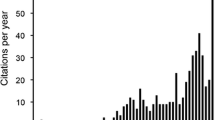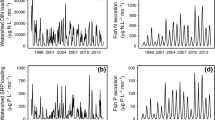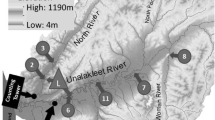Abstract
Migratory animals can alter ecosystem function via the provision of nutrient subsidies. These subsidies are heterogeneous in space and time, which may create hot spots or hot moments in biogeochemical transformations, in turn altering the ecosystem effect of the subsidy by changing the form of the nutrients. Annual migrations of Pacific salmon (Oncorhynchus spp.) transport nutrients from the marine environment to their natal freshwater ecosystems. Salmon subsidies provide high quality nutrients (e.g., nitrogen, phosphorus, carbon) that may also be large in quantity where salmon migrations are near historic levels. We hypothesized that the nutrient subsidy provided via the excretion of ammonium (NH4 +) by live salmon would stimulate microbially mediated nitrification rates in stream sediments and increase streamwater nitrate (NO3 −) concentrations. We quantified sediment nitrification in seven streams in Southeast Alaska before and during the salmon run in 2007 and 2008. Nitrification rates increased 3-fold from before to during the salmon run (mean ± SE = 0.07 ± 0.01 to 0.24 ± 0.02 mgN gAFDM−1 d−1, respectively). The variation in nitrification was explained by both streamwater and exchangeable NH4 + concentrations (R 2 = 0.50 and 0.71, respectively), which were low before salmon and increased relative to the size of the salmon run. To experimentally test the effect of salmon subsidies on nitrification rates, we staked senesced salmon carcasses on stream sediments for 3 weeks during the salmon run and then measured nitrification rates directly under the carcasses. Sediment nitrification was 2–5 times higher under the carcasses compared to nearby sediments without the direct carcass influence. Our results confirm that biogeochemical transformations alter the form of salmon-derived nitrogen, representing an overlooked aspect in the dynamics of this subsidy. Therefore, animal-derived nutrient subsidies are not passively retained or exported in recipient ecosystems, but also transformed, thereby influencing the form and incorporation of these nutrient subsidies.





Similar content being viewed by others
References
APHA (2005) Standard methods for the examination of water and wastewater, 20th edn. American Public Health Association, Washington
Arango CP, Tank JL (2008) Land use influences the spatiotemporal controls on nitrification and denitrification in headwater streams. J N Am Benthol Soc 27:90–107
Ashkenas LR, Johnson SL, Gregory SV, Tank JL, Wollheim WM (2004) A stable isotope tracer study of nitrogen uptake and transformation in an old-growth forest stream. Ecology 85:1725–1739
Bernhardt ES, Hall RO, Likens GE (2002) Whole-system estimates of nitrification and nitrate uptake in streams of the Hubbard Brook Experimental Forest. Ecosystems 5:419–430
Bruesewitz DA, Tank JL, Bernot MJ, Richardson WB, Strauss EA (2006) Seasonal effects of the zebra mussel (Dreissena polymorpha) on sediment denitrification rates in Pool 8 of the Upper Mississippi River. Can J Fish Aquat Sci 63:957–969
Bunte K, Abt SR (2001) Sampling frame for improving pebble count accuracy in coarse gravel-bed streams. J Am Water Resour As 37:1001–1014
Cak AD, Chaloner DT, Lamberti GA (2008) Effects of spawning salmon on dissolved nutrients and epilithon in coupled stream-estuary systems of southeastern Alaska. Aquat Sci 70:169–178
Chaloner DT, Lamberti GA, Merritt RW, Mitchell NL, Ostrom PH, Wipfli MS (2004) Variation in responses to spawning Pacific salmon among three south-eastern Alaska streams. Freshwater Biol 49:587–599
Compton JE, Church MR, Larned ST, Hogsett WE (2003) Nitrogen export from forested watersheds in the Oregon Coast Range: the role of N2-fixing red alder. Ecosystems 6:773–785
Dortch Q (1990) The interaction between ammonium and nitrate uptake in phytoplankton. Mar Ecol-Prog Ser 61:183–201
Hall GH (1984) Measurement of nitrification rates in lake sediments: comparison of the nitrification inhibitors nitrapyrin and allylthiourea. Microb Ecol 10:25–36
Hall RO, Tank JL (2003) Ecosystem metabolism controls nitrogen uptake in streams in Grand Teton National Park, Wyoming. Limnol Oceanogr 48:1120–1128
Holtgrieve GW, Schindler DE, Jewett PK (2009) Large predators and biogeochemical hotspots: brown bear (Ursus arctos) predation on salmon alters nitrogen cycling in riparian soils. Ecol Res 24:1125–1135
Howarth RW, Marino R (2006) Nitrogen as the limiting nutrient for eutrophication in coastal marine ecosystems: evolving views over three decades. Limnol Oceanogr 51:364–376
Janetski DJ, Chaloner DT, Tiegs SD, Lamberti GA (2009) Pacific salmon effects on stream ecosystems: a quantitative synthesis. Oecologia 159:583–595
Johnston NT, MacIsaac EA, Tschaplinski PJ, Hall KJ (2004) Effects of the abundance of spawning sockeye salmon (Oncorhynchus nerka) on nutrients and algal biomass in forested streams. Can J Fish Aquat Sci 61:384–403
Kemp MJ, Dodds WK (2001) Spatial and temporal patterns of nitrogen concentrations in pristine and agriculturally-influenced prairie streams. Biogeochemistry 53:125–141
Levi PS, Tank JL, Tiegs SD, Rüegg J, Chaloner DT, Lamberti GA (2011) Does timber harvest influence the dynamics of marine-derived nutrients in Southeast Alaska streams? Can J Fish Aquat Sci 68:1316–1329
Marcarelli AM, Baxter CV, Mineau MM, Hall RO (2011) Quantity and quality: unifying food web and ecosystem perspectives on the role of resource subsidies in freshwaters. Ecology 92:1215–1225
Maron JL, Estes JA, Croll DA, Danner EM, Elmendorf SC, Buckelew SL (2006) An introduced predator alters Aleutian Island plant communities by thwarting nutrient subsidies. Ecol Monogr 76:3–24
McClain ME, Boyer EW, Dent CL, Gergel SE, Grimm NB, Groffman PM, Hart SC, Harvey JW, Johnston CA, Mayorga E, McDowell WH, Pinay G (2003) Biogeochemical hot spots and hot moments at the interface of terrestrial and aquatic ecosystems. Ecosystems 6:301–312
McIntyre PB, Flecker AS, Vanni MJ, Hood JM, Taylor BW, Thomas SA (2008) Fish distributions and nutrient cycling in streams: can fish create biogeochemical hotspots? Ecology 89:2335–2346
Mitchell NL, Lamberti GA (2005) Responses in dissolved nutrients and epilithon abundance to spawning salmon in Southeast Alaska streams. Limnol Oceanogr 50:217–227
Moore JW, Schindler DE, Scheuerell MD (2004) Disturbance of freshwater habitats by anadromous salmon in Alaska. Oecologia 139:298–308
Mulholland PJ, Tank JL, Sanzone DM, Wollheim WM, Peterson BJ, Webster JR, Meyer JL (2000) Nitrogen cycling in a forest stream determined by a N-15 tracer addition. Ecol Monogr 70:471–493
Mulholland PJ, Helton AM, Poole GC, Hall RO, Hamilton SK, Peterson BJ, Tank JL, Ashkenas LR, Cooper LW, Dahm CN, Dodds WK, Findlay SEG, Gregory SV, Grimm NB, Johnson SL, McDowell WH, Meyer JL, Valett HM, Webster JR, Arango CP, Beaulieu JJ, Bernot MJ, Burgin AJ, Crenshaw CL, Johnson LT, Niederlehner BR, O’Brien JM, Potter JD, Sheibley RW, Sobota DJ, Thomas SM (2008) Stream denitrification across biomes and its response to anthropogenic nitrate loading. Nature 452:202–255
Peterson BJ, Wollheim WM, Mulholland PJ, Webster JR, Meyer JL, Tank JL, Marti E, Bowden WB, Valett HM, Hershey AE, McDowell WH, Dodds WK, Hamilton SK, Gregory SV, Morrall DD (2001) Control of nitrogen export from watersheds by headwater streams. Science 292:86–90
Polis GA, Anderson WB, Holt RD (1997) Toward an integration of landscape and food web ecology: the dynamics of spatially subsidized food webs. Annu Rev Ecol Syst 28:289–316
Polis GA, Power ME, Huxel GR (eds) (2004) Food webs at the landscape level. University of Chicago Press, Chicago
Quinn TP (2005) The behavior and ecology of Pacific salmon and trout. University of Washington Press, Seattle
Raven JA, Wollenweber B, Handley LL (1992) A comparison of ammonium and nitrate as nitrogen sources for photolithotrophs. New Phytol 121:19–32
Schindler DE, Scheuerell MD, Moore JW, Gende SM, Francis TB, Palen WJ (2003) Pacific salmon and the ecology of coastal ecosystems. Front Ecol Environ 1:31–37
Strauss EA, Mitchell NL, Lamberti GA (2002) Factors regulating nitrification in aquatic sediments: effects of organic carbon, nitrogen availability, and pH. Can J Fish Aquat Sci 59:554–563
Strauss EA, Richardson WB, Bartsch LA, Cavanaugh JC, Bruesewitz DA, Imker H, Heinz JA, Soballe DM (2004) Nitrification in the Upper Mississippi River: patterns, controls, and contribution to the NO3 − budget. J N Am Benthol Soc 23:1–14
Stream Solute Workshop (1990) Concepts and methods for assessing solute dynamics in stream ecosystems. J N Am Benthol Soc 9:95–119
SYSTAT 12 (2007) Systat Software, Inc, Chicago
Tank JL, Rosi-Marshall EJ, Baker MA, Hall RO (2008) Are rivers just big streams? A pulse method to quantify nitrogen demand in a large river. Ecology 89:2935–2945
Tiegs SD, Chaloner DT, Levi P, Rüegg J, Tank JL, Lamberti GA (2008) Timber harvest transforms ecological roles of salmon in southeast Alaska rain forest streams. Ecol Appl 18:4–11
Tiegs SD, Levi PS, Rüegg J, Chaloner DT, Tank JL, Lamberti GA (2011) Ecological effects of live salmon exceed those of carcasses during an annual spawning migration. Ecosystems 14:598–614
Webster JR, Mulholland PJ, Tank JL, Valett HM, Dodds WK, Peterson BJ, Bowden WB, Dahm CN, Findlay S, Gregory SV, Grimm NB, Hamilton SK, Johnson SL, Marti E, McDowell WH, Meyer JL, Morrall DD, Thomas SA, Wollheim WM (2003) Factors affecting ammonium uptake in streams—an inter-biome perspective. Freshwater Biol 48:1329–1352
Zar JH (2009) Biostatistical analysis, 4th edn. Prentice-Hall, Upper Saddle River, NJ
Acknowledgments
Our research was possible because of the field and technical support provided by J. Berkowitz, N. Bonzey, M. Brueseke, E. Campbell, S. Hebbeler, J. Junker, A. M. Larquier, S. Meyer, J. Rüegg, M. Stephen, C. Turner, and S. Winikoff. We are grateful to B. Hall, D. Janetski, S. Roley, J. Rüegg, and M. Vanni for insightful comments on earlier versions of this manuscript. We also thank the Craig and Thorne Bay Ranger Districts for logistical support on Prince of Wales Island, and the support of the USDA Forest Service Pacific Northwest Research Station Aquatic-Land Interactions Program. Funding for this research was provided by USDA-CSREES National Research Initiative (Managed Ecosystems Program 2006-35101-16566) and NSF-IGERT training grant (DGE-0504495).
Author information
Authors and Affiliations
Corresponding author
Rights and permissions
About this article
Cite this article
Levi, P.S., Tank, J.L., Tiegs, S.D. et al. Biogeochemical transformation of a nutrient subsidy: salmon, streams, and nitrification. Biogeochemistry 113, 643–655 (2013). https://doi.org/10.1007/s10533-012-9794-0
Received:
Accepted:
Published:
Issue Date:
DOI: https://doi.org/10.1007/s10533-012-9794-0




